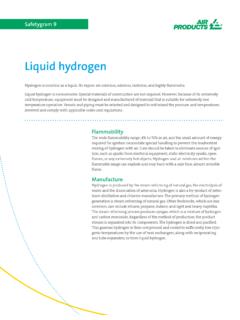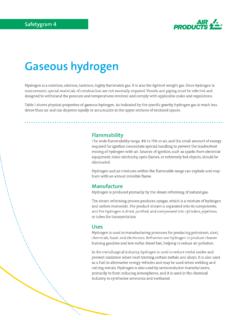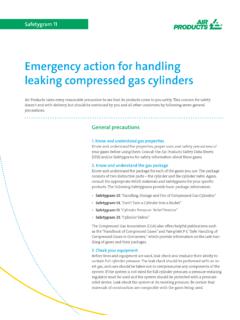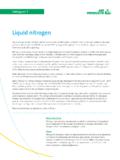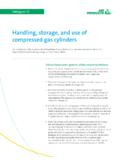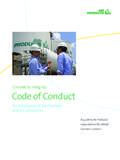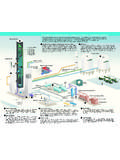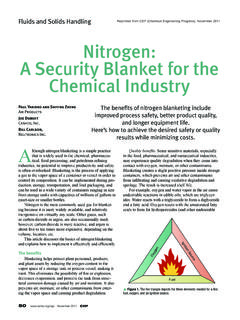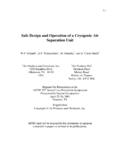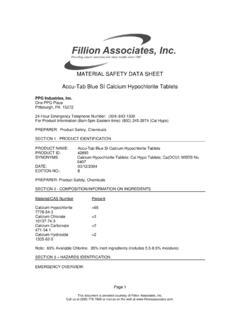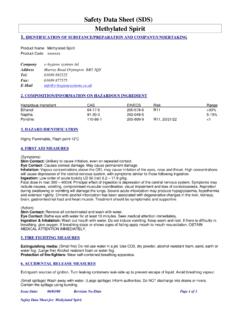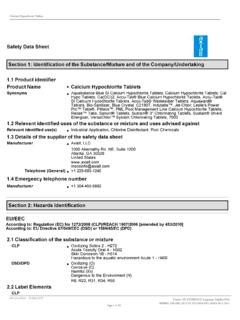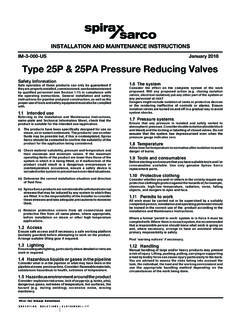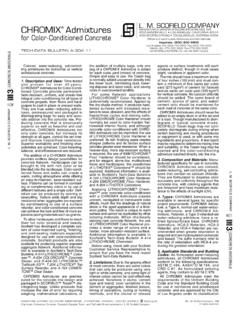Transcription of Polyurethane Amine Catalysts - Air Products & Chemicals
1 Polyurethane Amine Catalysts product Stewardship Summary Amine Catalysts can be used in a variety of Polyurethane foam applications, including automobile seat cushions, upholstered furniture and mattresses, refrigerators and freezers, and roof and wall insulation. Every day these durable Products make our lives more comfortable, supportive and safer. Common Polyurethane Amine Catalysts include triethylenediamine, pentamethyldiethylene- triamine and dimethylcyclohexylamine. Uses and Benefits Air Products ' Amine Catalysts Polyurethane foams are one of the most versa- Type Uses tile materials available. Foam can be created in almost any variety of shape and firmness. Foam Slabstock Balanced production is comparable to bread making.
2 Blowing Flexible Flexible Molded Gelling Foam Foam Foam ingredients are mixed; they react and rise product to resemble a loaf of bread. However, unlike Trade Name bread making, foam production is much more Reduced- DABCO NE300 4. controlled and Catalysts play a key role. In a Emission Catalysts DABCO NE1070. 4. typical foam mixture, a catalyst may acceler- DABCO RE530 4. ate the gelling reaction or promote the blowing (gas-forming) reaction. POLYCAT 30 4. New Catalysts are continuously introduced POLYCAT 31 4. to help foam producers precisely control cell Traditional DABCO 33 LV. 4. structure, reduce emissions and improve Catalysts DABCO BL-19 4. foam performance. New reduced-emission, DABCO DMEA. 4. high-efficiency Catalysts help manufactur- ers create eco-friendly foams.
3 Examples of DABCO T 4. these reduced-emission Catalysts along with POLYCAT 5 4. traditional Catalysts are shown in the table to POLYCAT 8 4. the right. Pictures and descriptions of flexible slabstock foam, flexible molded foam and rigid POLYCAT 9 4. foam applications are shown on the next page. POLYCAT 12 4. POLYCAT 15 4. POLYCAT 17 4. POLYCAT 41 4. POLYCAT 77 4. Flexible Slabstock Foam Flexible Molded Foam Rigid Foam Foam mixture poured on moving conveyor Foam mixture poured into shaped molds. Foam injected between plastic and metal and expands to a slab. Durable, comfort- For comfort, energy and sound absorption, cabinet. Higher energy efficiencies for able support for furniture cushioning and moisture and heat resistance in automotive insulation foams, including spray, board bedding.
4 Interiors, and flexibility and resiliency for laminate and refrigerator formulations. office furniture design. Physical and chemical Environmental Effects Properties The process used to manufacture Polyurethane These Amine Catalysts are alkaline. Amines foam is well controlled and designed to be have a fish-like odor. Dabco DMEA, Dabco T, environmentally safe. Amine Catalysts are typi- Dabco RE530, Polycat Catalysts 5, 8, 15, 30, cally to percent of a foam formulation. 31, and 77 are combustible liquids. All of the These amines tend to break down rapidly in the Amine Catalysts in the Amine Catalysts table atmosphere and therefore are unlikely to accu- are water-soluble, with the exception of Polycat mulate significantly in the environment.
5 Catalysts 5, 8 ,and 12. Health Effects Liquid Amine Catalysts are corrosive to skin and there is no long-term effect. Although it is and eyes and can cause burns. Because Amine not harmful to the eyes, blue haze may place vapors cause nose, throat and lung irritation, air a person at risk for accidental injury due to emissions are controlled in industrial settings. impaired vision. For more information, consult Amine vapors are also irritating to the eyes at Safetygram 32, The Facts About Amine -Induced very low concentrations. Some workers have Visual Disturbances: Halovision-Blue Haze- observed blurred or foggy vision with a blue tint Glaucopsia. ( blue haze ) and sometimes a halo phenom- enon around lights. This symptom is temporary Exposure Potential and Risk Management Measures Industrial Use The manufacture of Polyurethane foam is concentrations below recommended exposure closely regulated for environmental, health, limits, workers must use air-purifying respira- and safety aspects at the local, state and tors.
6 Where there is a possibility of exposure to federal levels. In all processes and operations, Amine Catalysts , workers must wear a full-face manufacturers are required to meet demanding shield over chemical goggles, gloves, long- emissions and workplace safety requirements. sleeved coveralls and safety shoes or rubber It is important to provide adequate ventilation in boots. work areas. In some cases, emissions from the process are handled by local exhaust ventila- Consumer Use tion and treatment systems designed to draw We sell Amine Catalysts to industrial manu- vapors away from the worker's breathing zone. facturers, not the public. Foams that are made Where engineering controls are not feasible with the Amine Catalysts are used in a variety of and work practices do not reduce Amine vapor consumer Products .
7 Regulatory Information Sources for Additional Several regulations govern the manufacture, Information sale, transportation, use and disposal of Amine Air Products Material Safety Data Sheets Catalysts . These laws vary by country and geo- graphic region. You can find general regulatory Air Products Polyurethane Additives information in the Material Safety Data Sheet. Air Products Safetygrams Center for the Polyurethanes Industry Conclusion Amine Catalysts can be used for the production of Polyurethane foams. Users can handle Amine Catalysts safely with minimal environmental effects when they follow industry and company guidelines. Contact Information Emergency Response System Technical Information Center Tel 1-800-523-9374 Tel 1-800-752-1597 ( ).
8 (Continental and Puerto Rico). Tel 1-610-481-8565 (other locations). Tel 1-610-481-7711 (other locations). Fax 1-610-481-8690. 24 hours a day, 7 days a week E-mail For assistance involving Air Products and Monday Friday, 8:00 5:00 EST. Chemicals , Inc. gases and equipment We developed this product Stewardship Summary to give you a general overview of the chemical . This Summary is not meant to pro- vide emergency response or medical treatment information. You can find in-depth safety and health information on the Material Safety Data Sheet for the product . tell me more Air Products and Chemicals , Inc., 2010 (32020) 900-10-006-US.
